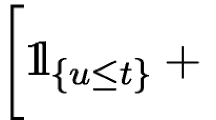Abstract
A version of Craig-Sakamoto's theorem says essentially that ifX is aN(O,I n ) Gaussian random variable in ∝n, and ifA andB are (n, n) symmetric matrices, thenX′AX andX′BX (or traces ofAXX′ andBXX′) are independent random variables if and only ifAB=0. As observed in 1951, by Ogasawara and Takahashi, this result can be extended to the case whereXX′ is replaced by a Wishart random variable. Many properties of the ordinary Wishart distributions have recently been extended to the Wishart distributions on the symmetric cone generated by a Euclidean Jordan algebraE. Similarly, we generalize there the version of Craig's theorem given by Ogasawara and Takahashi. We prove that ifa andb are inE and ifW is Wishart distributed, then Tracea.W and Traceb.W are independent if and only ifa.b=0 anda.(b.x)=b.(a.x) for allx inE, where the. indicates Jordan product.
Similar content being viewed by others
References
Casalis, M. (1990). Familles exponentielles naturelles invariantes par un groupe, Ph.D. Thesis, Laboratoire de Statistique et Probabilités, Université Paul Sabatier, Toulouse.
Casalis, M. (1991). Les familles exponentielles à variance quadratique homogène sont des lois de Wishart sur un cöne symétrique.C. R. Acad. Sc. Paris,312, 537–540.
Casalis, M. and Letac, G. (1994). Characterization of the Jorgensen set in the generalized linear model,Test,3, 145–161.
Driscoll, M. F. and Gundberg, W. R. (1986). A history of the development of Craig's theorem,Amer. Statist.,40, 65–70.
Faraut, J. (1988). Algèbres de Jordan et cônes symétriques, Notes d'un Cours d'Eté du Centre International de Mathématiques Pures et Appliquées, Département de Mathématiques, Université de Poitiers.
Faraut, J. and Koranyi, A. (1994).Analysis on Symmetric Cones, Oxford University Press, Oxford.
Gindikin, S. (1975). Invariant generalized functions in homogeneous spaces.J. Funct. Anal. Appl.,9, 50–52.
Jacobson, N. (1968). Structure and representations of Jordan algebras,Amer. Math. Soc. Collog. Publ.,XXXXIX, Providence, Rhode Island.
Jensen, S. (1988). Covariance hypotheses which are linear in both the covariance and in the inverse covariance,Ann. Statist.,16, 302–322.
Kallenberg, O. (1991). On an independence criterion for multiple Wiener integrals,Ann. Probab.,19, 83–85.
Lancaster, H. O. (1954). Traces and cumulants of quadratic forms in the normal variables,J. Roy. Statist. Soc. Ser. B,16, 247–254.
Letac, G. (1994). Les familles exponentielles statistiques invariantes par les groupes du cône et du paraboloïde de révolution,Volume in Honor of L. Takaćs (eds. J. Galambos and J. Gani), Applied Probability Trust, Sheffield.
Lévy, P. (1948). The arithmetical character of the Wishart distribution,Proc. Cambridge Philos. Soc.,44, 255–297.
Massam, H. (1994). An exact decomposition theorem and a unified view of some related distributions for a class of exponential transformation models on symmetric cones,Ann. Statist.,22, 369–394.
Massam, H. and Neher, E. (1994). On transformations and determinants of Wishart variables on symmetric cones (submitted).
Matusita, K. (1949). Note on the independence of certain statistics,Ann. Inst. Statist. Math.,1, 79–82.
Muirhead, R. J. (1982).Aspects of Multivariate Statistical Theory, Wiley, New York.
Ogasawara, T. and Takahashi, M. (1951). Independence of quadratic quantities in a normal system,Journal of Science of the Hiroshima University, Series A,15, 1–9.
Ogawa, J. (1949). On the independence of bilinear and quadratic forms of a random sample from a normal population,Ann. Inst. Statist. Math.,1, 83–108.
Ogawa, J. (1993). A history of the development of Craig-Sakamoto's theorem viewed from Japanese standpoint,Proc. Inst. Statist. Math.,21, 47–59 (in Japanese).
Olkin, I. (1990). Interface between statistics and linear algebra,Proc. Sympos. Appl. Math.,40, 233–256.
Rothaus, O. (1968). Some properties of Laplace transforms of measures,Trans. Amer. Math. Soc.,131, 163–169.
Sakamoto, H. (1944). On the independence of statistics, Research Memo.1, The Institute of Statistical Mathematics, Tokyo (in Japanese).
Satake, I. (1980).Algebraic Structures on Symmetric Domains, Iwanami-Shoten, Tokyo and Princeton University Press, Princeton.
Shanbhag, D. N. (1988). The Davidson-Kendall problem and related results on the structure of the Wishart distribution,Austral. J. Statist.,30A, 272–280.
Ustünel, A. S. and Zakaï, M. (1989). On independence and conditioning on Wiener space,Ann. Probab.,17, 1441–1453.
Author information
Authors and Affiliations
Additional information
Partially supported by NATO grant 92.13.47.
About this article
Cite this article
Letac, G., Massam, H. Craig-Sakamoto's theorem for the Wishart distributions on symmetric cones. Ann Inst Stat Math 47, 785–799 (1995). https://doi.org/10.1007/BF01856547
Received:
Revised:
Issue Date:
DOI: https://doi.org/10.1007/BF01856547



